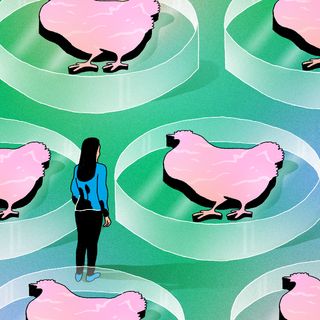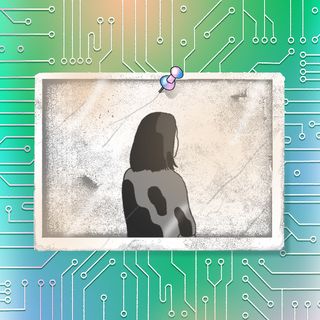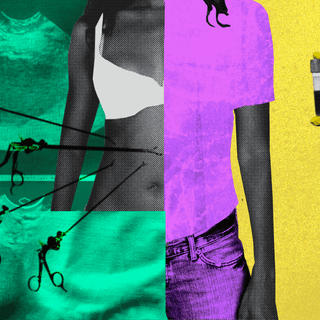
Artificial Wombs to Enhanced Babies, How Ethical is the Future of Birth?
Reproductive technologies could liberate women from the burden of pregnancy, but remain fraught with controversy.

In The Future Of, we unpack technology’s growing influence on our lives to answer the pressing question — What lies ahead?
“A single building can incubate up to 30,000 lab-grown babies per year.”
This is Ecto Life’s vision for the future of birth, as outlined in a widely covered concept video last December. It boasted of 75 highly-equipped labs, each with 400 “growth pods” – or artificial wombs – that replicate the exact conditions of a uterus. The baby in each pod would receive customized nutrients determined by an artificial intelligence-based system, while parents would be able to track their baby’s growth progress and vital signs from their phones. Except Ecto Life doesn’t exist – yet.
Though many reports touted Ecto Life to be the “world’s first artificial womb facility,” concept creator Hashem Al-Ghaili – a producer, filmmaker and science communicator – confirmed to Reuters that this is only a conceptualization of the future of birth. Still, artificial womb technology (AWT) has a long history, with some researchers actively working on it with the primary aim of helping premature babies complete gestation outside their mother’s womb.
New reproductive technologies could unarguably provide several benefits – from allowing infertile or queer couples to reproduce biologically, and improving neonatal care for preterm babies, to reducing risks of pregnancy. There has been considerable progress on this front. Researchers have created sperms from stem cells, which eventually fertilized rat eggs and led to healthy offspring. Elsewhere, scientists managed to grow an embryo in the lab and sustain it for two weeks, before destroying it so they wouldn’t breach the legal 14-day limit imposed on such research. AI is also being used to predict pregnancy risks and outcomes, making deliveries safer for both woman and child.
With childbirth being intricately linked to women’s constructed roles in society, some even claim such technology could usher in a feminist future of birth by liberating women from the pain and trauma of pregnancy.
AWT envisions a future where technology will render C-sections and premature birth redundant, and solve infertility. As the Ecto Life video progresses, however, the ethics of such a future where babies can be manufactured in laboratories grows murkier. “And if you want your baby to stand out and have a brighter future, our Elite Package offers you the opportunity to genetically engineer the embryo…” the voiceover continues. It says, parents will be able to edit their baby’s traits, customizing everything from their hair color to their height and level of intelligence – thus evoking the same concerns that led to a raging debate on “designer babies” not long ago.
Artificial wombs
A primary argument often brought up in favor of artificial wombs is that it could revolutionize reproductive labor. This idea goes back several decades to biologist J.B.S. Haldane who first coined the scientific term ‘ectogenesis’ for development or gestation in an artificial environment. “Ectogenesis was, for Haldane, the perfect example of how science could bring about radical social change: by freeing women from the necessity of pregnancy, sex and reproduction would be uncoupled, which would, he believed, drastically change the imbalance of power in society,” Oscar Schwartz wrote while documenting the history of the artificial womb. The Conversation further noted Haldane’s predictions that by 2074, more than 70% of humans would be born from an artificial womb.
Other progressive thinkers were reportedly quick to take up Haldane’s idea. According to Schwartz, feminist Shulamith Firestone wrote in The Dialectic of Sex that outsourcing pregnancy to machines was the only way to achieve true equality between men and women. In their eyes, artificial wombs, then, assume a form of feminist technology for women’s liberation.
It could also help mitigate preterm complications. According to the World Health Organization, an estimated 15 million children are born preterm (before 37 weeks of gestation). Preterm birth complications are the leading cause of death among children under 5 years of age. Those who survive may face a “lifetime of disability.” With AWT, the vision is that premature babies can continue to develop in pods that mimic amniotic sacs, allowing their lungs and organs to attain full functionality.
In 2017, a research team from the Children’s Hospital of Philadelphia (CHOP) said they had found a way to gestate lamb fetuses outside the bodies of sheep. They had created what they called the ‘Biobag’ – an invention that simulates the environment in the uterus as closely as possible.
When the lambs had grown to the equivalent of a human fetus at 23-24 weeks – considered the age of viability for human babies – they were removed from their mother’s wombs by C-section, and placed in the ‘Biobag’. This temperature-controlled, nearly-sterile bag acts like an amniotic sac, and was filled with amniotic fluid produced in the laboratory, reported The Guardian, while vital signs can be monitored electronically. “Our system could prevent the severe morbidity suffered by extremely premature infants by potentially offering a medical technology that does not currently exist,” Alan W. Flake, the study’s lead author, said at the time.
Related on The Swaddle:
Pregnancy Is an Uncomfortable Experience – Why Hasn’t Medical Science Made It Easier?
Even though the lambs didn’t develop from an embryonic stage in the Biobag, it is the closest the world has come to an artificial womb. A few months later, Women & Infants Research Foundation (WIRF) in Western Australia published a paper on EVE therapy – their version of the artificial womb that combines a “high-tech amniotic fluid bath” with an “artificial placenta,” developed in collaboration with researchers from Tohoku University hospital in Japan.
The development of the Biobag and EVE Therapy led to a spurt of reports analyzing the ethical and legal challenges that could crop up if this technology becomes commercially viable, which would occur only after research in animals has been successfully translated to humans. In 2020, Matt Kemp, professor at WIRF, told The Guardian, “Getting this into clinical use is going to be incredibly difficult.” There could be several risks attached for premature babies, who are supposed to be the beneficiaries of this technology. “To create an argument an ethical committee will buy, you’ve got to have an odds-on chance of delivering an outcome far better than the technology currently in use,” Kemp said.
Meanwhile, Carlo Bulletti, associate professor at Yale University’s department of obstetrics, gynecology, and reproductive science, told Vice in 2018 that the benefits of an artificial womb extend far beyond ensuring the survival of premature babies. This technology could allow same-sex male couples, as well as women who suffer uterine complications to reproduce biologically, leading to, in Bulletti’s words, “new parenthood balance where men and women will no longer have primary and secondary roles.” It could also eliminate the need for surrogacy, and the exploitative conditions in which it often operates.
As Dr. Anna Smajdor, a bioethicist and philosopher, told The Guardian: “Pregnancy is barbaric.” The long-term physical and mental effects of the experience on women are under-acknowledged due to the values society attaches to notions of motherhood and childbirth.
These societal perceptions of childbirth are probably why the argument that artificial wombs would relieve women from the “natural” burden of childbirth don’t appeal to all. But there are many legal and regulatory hurdles that lie in the path of AWT for humans, including determining which babies become subjects in clinical trials. A paper published in BMC Medical Ethics in 2021 noted, “The experimental use of AWT on preterms will not only expose research subjects to unknown short- and long-term risks, but it will also come with concerns about the validity of parental consent in such emotionally challenging and distressing circumstances.”
Even in improving life expectancy of premature babies, several ethical questions emerge, such as the possibility of “inappropriate application of the technology to extend the limits of viability.” Dr. Flake told The New York Times that prime candidates for this technology would be “infants that would currently not be resuscitated” for being born before the 23-24 weeks of gestation. This could further complicate abortion rights and women’s bodily autonomy as, by pushing this limit of viability lower, “abortion could become impermissible under legislations that tie abortion rights to the standard of viability,” noted the 2021 paper.
Artificial wombs thus, once again, bring up the long-standing debate that weighs a fetus’s life against reproductive autonomy. The 2021 paper further noted that the controversial technology was seen as more acceptable when arguments about ensuring survival of preterm fetuses and allowing women with uterine complications to reproduce are employed. Further, AWT’s emancipatory potential for women has also been noted to be quite limited. Artificial wombs could ensure a fair redistribution of reproductive labor only if this labor is limited to pregnancy, Sasha Isaac wrote in Aeon. Women’s roles, however, do not end there, but extend long after, from breastfeeding the newborn to raising the child. For all the talk of liberating women from “physical oppression” associated with the reproductive process, artificial wombs do not address the patriarchal values that lie at its roots, continuing to invisibilize not only the pain and trauma of pregnancy, but also women’s labor and care-giving responsibilities.
Designer babies
In 2018, Chinese scientist He Jiankui alarmed the world by claiming to have edited the genes of embryos to make them resistant to HIV, which led to the birth of the world’s first genetically edited babies. While Jiankui defended his risky research at the time, he faced severe consequences for “illegal medical practice.” He was fired from his university, and spent three years in jail, emerging from prison to say that he had moved “too quickly.” His work was also criticized for neglecting safety testing and failing to use standard procedures when acquiring consent from families.
Following the backlash to Jiankui’s research, a group of scientists, including the scientist behind the CRISPR-Cas9 gene editing technology, called for a global moratorium on germ-line editing – or the editing of human sperms, eggs, or embryos – as these would involve making changes to DNA that would then be passed onto future generations, posing unknown health risks.
The medical research community has long been divided on the merits, and demerits, of gene editing embryos. For some, such as bioethicist Dr. Kevin Smith from Abertay University, genetic editing of embryos is both “ethically justified” and “highly desirable,” as it would eliminate the risk of severe genetic diseases from being passed down over generations, extending disease-free lifespans. In 2019, Dr. Smith told BBC that the risks of gene editing are low enough for it to be used on embryos.
Related on The Swaddle:
Scientists Edit Human Embryo Genes Using CRISPR, Discover Major Unintended Edits
For others, the use of this technology in humans is highly contentious, as editing the embryo could also lead to the introduction of genetic mutations. The primary fear is that gene editing would eventually be employed for non-therapeutic purposes like creating “designer babies.” Some say, gene editing is not required – couples who know they carry a gene for inherited diseases can use preimplantation genetic diagnosis (PGD) to select embryos, as The Guardian reported. Under PGD, embryos produced by in vitro fertilization (IVF) are analyzed to determine their genetic makeup. The most suitable is selected, and then implanted. If new, more efficient harvesting technology is created and combined with advances in PGD, embryo selection could witness a massive growth spurt in coming decades, bioethicist Dr. Henry Greely of Stanford University told The Guardian back in 2017.
Moreover, designing babies and their traits, as per Ecto Life’s vision, is not that simple. Human traits are complex and characteristics such as height, intelligence and personality are not controlled by a single gene, but a combination of many. We know much less of how genes influence personality or intelligence, as compared to specific heritable diseases, Dr. Greely pointed out.
However, a future where gene editing is used for enhancement cannot be ruled out, bioethicist Ronald Green of Dartmouth College told The Guardian. This could have vast consequences for society, further widening the wealth and health gap between the rich and poor. This technology would most probably be limited to the wealthy, complicating social infrastructure and support for those who live with, or are born with, genetic diseases in the future. Choosing which diseases to edit for is another issue that could present itself as gene editing potentially becomes mainstream. Dr. Lea Witkowsky wrote, “Deciding where the line between prevention and enhancement lies will also be necessary. Making sure we preserve societal infrastructure for those individuals who will continue to be born with genetic diseases will be critical. Perhaps most importantly, engaging those communities directly affected by this application is essential.”
Many predict that if this technology becomes available for use, it would likely be for editing genes associated with diseases, and not for enhancing one’s capabilities and physical features. Ensuring regulatory frameworks and adequate scientific protocols that allow for the ethical use of this technology is then something countries may eventually have to grapple with. As Dr. Green said, “It is unavoidably in our future… and I believe that it will become one of the central foci of our social debates later in this century and in the century beyond.”
Ananya Singh is a Senior Staff Writer at TheSwaddle. She has previously worked as a journalist, researcher and copy editor. Her work explores the intersection of environment, gender and health, with a focus on social and climate justice.
Related


Memory Can be Enhanced, Manipulated, and Edited. Will the Future of Memory be Ethical?
